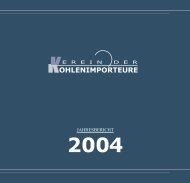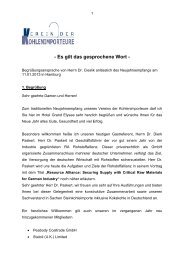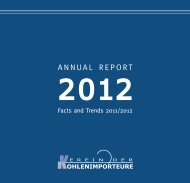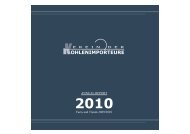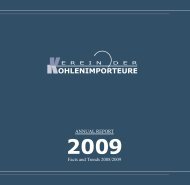Annual Report 2010 - Verein der Kohlenimporteure eV
Annual Report 2010 - Verein der Kohlenimporteure eV
Annual Report 2010 - Verein der Kohlenimporteure eV
Create successful ePaper yourself
Turn your PDF publications into a flip-book with our unique Google optimized e-Paper software.
In <strong>2010</strong>, hard coal output worldwide continued to<br />
increase, growing by approximately 600 million tonnes<br />
<br />
down into approximately 5.8 billion tonnes of steam coal<br />
and approximately 0.9 billion tonnes of coking coal.<br />
Over the last decade, since 2000, global hard coal output<br />
has grown by 86% or 3.1 billion tonnes. China is mainly<br />
responsible for this trend, alone increasing its production<br />
by 1.2 billion tonnes between 2005 and <strong>2010</strong>.<br />
Other countries have also increased production<br />
significantly. The majority of the worldwide growth in<br />
production comes from Asia, as trends in recent years<br />
show:<br />
Hard Coal Output of Major Countries<br />
<br />
Producing Countries 2008 2009 <strong>2010</strong><br />
China 2,761 2,910 3,410<br />
India 489 532 537<br />
Australia 334 344 355<br />
Indonesia 255 280 325<br />
Vietnam 40 43 50<br />
Total 3,879 4,109 4,677<br />
HT-W4 Source: IEA, <strong>2010</strong> provisional<br />
In addition to the above-mentioned countries, elsewhere<br />
in the Asian region substantial quantities of coal are still<br />
mined in North Korea, Mongolia and New Zealand.<br />
Outside booming Asia, developments in hard coal<br />
output varied. Output in North America remained<br />
almost stable, as domestic demand for steam coal<br />
declined. Additional demand came from an increase in<br />
exports of 19 million tonnes. US mining companies in<br />
the Appalachian coalfields are finding it increasingly<br />
difficult to obtain permits for mountaintop mining.<br />
Canada adjusted its hard coal production upwards,<br />
which is essentially aimed at export, in view of stronger<br />
demand for coking coal and PCI coal, reflecting the<br />
economic situation in the steel industry.<br />
In South America, Colombia in particular, increased its<br />
production because of increasing demand from Europe<br />
<br />
smaller coking coal deposits in Colombia attracted<br />
growing attention. Venezuela, by contrast, maintained<br />
production at a low level.<br />
Economic recovery enabled Russia to increase<br />
production. Output in South Africa stagnated at its 2009<br />
level. The many BEE (Black Economic Empowerment)<br />
groups will hopefully use their newly granted mining<br />
rights and start coal production. New coal projects are<br />
being examined mainly in Mozambique, but also in<br />
Botswana and in Zimbabwe.<br />
<br />
slightly from 135 million tonnes in 2009 to 134 million<br />
tonnes in <strong>2010</strong>, with declines in Poland and Germany.<br />
The sharp increases in world market prices towards the<br />
end of <strong>2010</strong> again strengthened the competitive position<br />
of indigenous European production.<br />
Ten Major Coal Producers in the World<br />
Company<br />
2008<br />
Mt<br />
2009<br />
Mt<br />
<strong>2010</strong> *<br />
Mt<br />
Coal India 403 431 431<br />
Peabody 1) 255 244 246<br />
Shenhua 186 210 225<br />
Arch1) 125 125 161<br />
China Coal 114 125 123<br />
BHP Billiton 116 104 103<br />
Anglo American 100 95 97<br />
SUEK 96 91 90<br />
Xstrata 86 85 80<br />
Rio Tinto 153 132 73<br />
1) <br />
HT-W5 Sources: The McCloskey Group <strong>2010</strong>, own estimate*,<br />
Business <strong>Report</strong>s<br />
15



